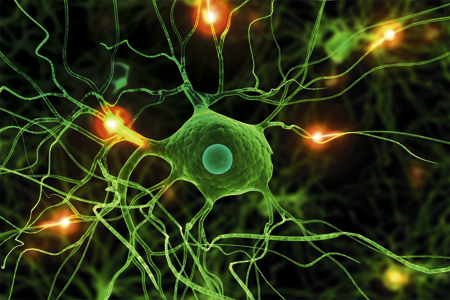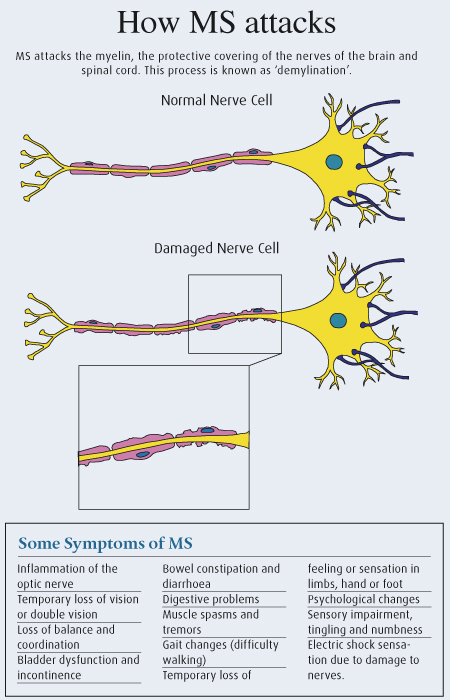
Living with Multiple Sclerosis
Issue 67 April 2010
Multiple Sclerosis is a disease that has affected more than 2.5 million people worldwide. Dr. Noreen A Kassem discusses this incurable disease.
Multiple sclerosis (MS) is a group of neurological diseases which often damage the spinal cord in scattered areas, giving rise to a range of symptoms. MS attacks the myelin, the protective covering of the nerves of the brain and spinal cord. This causes inflammation and distorts the usual flow of nerve impulses along nerve fibres.
The result is a wide variety of MS symptoms, depending on what part or parts of the central nervous system are affected in different individuals.
An inflammatory, auto-immune disease of the central nervous system, MS affects twice as many women as men and generally strikes in the early adult years between the ages of twenty and forty years. It is thought to be the most common neurological disease in young people, affecting approximately 85,000 people in the UK and almost 2.5 million worldwide. Latitude is also thought to play a role. Multiple sclerosis is five times more likely in temperate regions, such as North America and Europe than in tropical areas. Canada has the highest incidence of this disease, followed by Sweden, Denmark, Norway and Scotland. Sevent people are diagnosed with MS everyday in the UK alone.
Potential Causes and Triggering Factors
It has not yet been established what exactly causes MS in certain individuals. However, numerous factors may contribute to the onset and progression of Multiple sclerosis, though the causes are more difficult to determine. MS may be hereditary, but a single gene has not yet been identified. People who have relatives with MS are more likely to develop it than people with no family history of the disease.
Like other auto-immune disorders, inflammation and immune cells in the body attacking nerve cells cause the symptoms of MS. Factors thought to trigger MS symptoms in susceptible individuals include emotional stress, viral infections, minor respiratory infection, allergic reactions, pregnancy, heat exposure, environmental toxins and toxins in the body such as lead dental fillings. Diet may also trigger or worsen the symptoms of MS, particularly in individuals with milk and gluten intolerances.

Treatment
Multiple sclerosis is currently treated with potent drug therapies that reduce the body’s inflammation and auto-immune reaction. These include medications such as cortisone and prednisone which reduce the severity of symptoms. Other medications include ones which change the body’s immune system and drugs that target specific symptoms such as fatigue and pain. New and ongoing research is resulting in new treatments with fewer side effects developing consistently.
Nutritional therapy is also very important in diseases such as MS in which the nerves are damaged and there are high levels of inflammation in the body. Several vitamins and long chain fatty acids such as omega-6 and omega-3 fatty acids help to reduce severity and duration of symptoms. In New Zealand, a study showed that fatty acids found in primrose oil improved the blood flow to the hands and feet of MS patients improving strength and coordination.
Food and supplements that contain high levels of antioxidants are also thought to help reduce damage in the body due to MS. Antioxidants include vitamin C, vitamin E, vitamin D and flavonoids which are found in plants. Vitamin B12, a key nutrient for metabolism and energy in the body, is also thought to support the myelin layer around nerve fibres which helps to conduct nerve impulses faster.
Case Study - Tasnim Iqbal, 43
In November 2002, I was diagnosed with MS. Within four days I went from being very active (having recently competed in the London Marathon) to being partially paralysed on my right side and not being able to keep a thought in my head.
I also started to experience some problems with my sight. My right eye would swell, causing unbearable amounts of pain and a loss of vision.
I was prescribed steroids to combat the swelling and inflammation but the side effects of weight loss and acne were tremendous. I decided to stop taking the medication and sought alternative treatment, one of which was physiotherapy. After a few sessions, my physiotherapist noticed an injury in my upper neck. She encouraged me to keep a journal of our sessions and I noticed that when my cervical vertebra (found in the upper neck) was out of alignment, my MS symptoms would get worse. We worked together to combat this and five years later I am working full time, using both sides of my body. There is no cure for MS but sometimes alternative therapies can be a God-send.
Useful MS and Disability Resources
Resources on Multiple Sclerosis and MS, including articles, news, information, message forums and chat rooms, email, books, videos and newsletters
The Multiple Sclerosis Resource Centre
The Multiple Sclerosis Resource Centre (MSRC) provides information on Multiple Sclerosis, MS symptoms, treatments, research news & MS resources
For more health related articles in emel, click here
Bookmark this |
|
Add to DIGG |
|
Add to del.icio.us |
|
Stumble this |
|
Share on Facebook |
|
Share this |
|
Send to a Friend |
|
Link to this |
|
Printer Friendly |
|
Print in plain text |
|


Comments
0 Comments